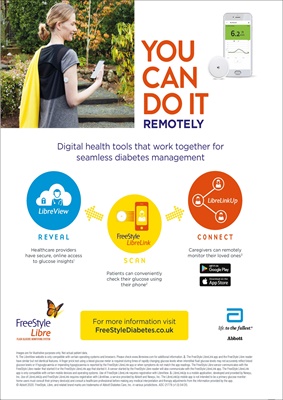
23
LIVING
we should just improve the sensors
for the CGM devices we have
already and, so far, the successes
are few. However, demand is high
and research and development
continues apace.
Here is an overview of what is
available now as well as some of
the most promising devices on
the horizon.
Minimally invasive
This method of measuring sugar
levels has rocketed in popularity
in the past few years. Since flash
glucose monitoring by Abbott's
FreeStyle Libre became available
on the NHS to people with Type 1
diabetes in April 2019, over half of
those with the condition in the UK
have migrated from finger pricking
to the Libre. And at the end of March
this year, NICE widened the choice
further, with all adults with Type 1
being eligible for a choice of either
flash or CGM on the NHS, all children
with Type 1 offered access to CGM,
and adults with Type 2 diabetes who
inject insulin at least twice a day also
eligible for flash monitoring if they
have severe hypos or a disability that
prevents them finger-prick testing.
Whereas CGM transmits
information about glucose levels
continuously via Bluetooth, flash -
specifically Abbott's FreeStyle Libre -
gives this information when you pass
your mobile or other device over the
sensor. The FreeStyle Libre has been
shown to improve blood sugar and
quality of life. A recent University of
Manchester study of 156 people with
Type 1 diabetes using the FreeStyle
Libre 2 found that participants'
HbA1c dropped by 8.46 mmol/mol
on average after 24 weeks, reducing
their risk of diabetes-related
complications over time. They also
reported being happier with their
diabetes treatment and suffered
less emotional strain associated
with living with the condition. The
newly available FreeStyle Libre 3
is essentially a CGM device. The
system sends real-time glucose
readings every minute to the user's
smartphone, and its sensor is the
smallest currently available. However,
it is unlikely to be made available on
the NHS.
Available CGM systems in the
UK are:
• A6 Touchcare Nano from Medtrum,
which sends glucose readings
every two minutes from a sensor
that lasts 14 days.
• Dexcom G6, considered the most
accurate, giving readings every
five minutes, though sensors have
to be changed every ten days. The
new G7 with a sensor that is 60%
smaller is more accurate still, with
a mean absolute relative difference
(MARD) of 8.2.%, compared to
9% for the G6 and 9.3% for the
Libre 2. With MARD, it's the lower
the better!
• Eversense, is a sensor that lasts
for six months, but it has to be
implanted (and later removed
and replaced) by a healthcare
professional, making it the most
invasive CGM available.
• Guardian Connect from Medtronic,
which compiles time-in-range
data, though the Guardian Sensor 3
that goes with it has to be changed
every seven days.
Both flash and CGM devices measure
the glucose in interstitial body fluid
(the fluid surrounding cells), and
allow you to see what your levels
are doing day and night, and what
affects them. Alarms on most devices
can alert you to an imminent hypo,
invaluable if you are hypo unaware,
and the data from your monitor
can also be made available to your
healthcare provider. Unlike flash,
CGM can be used with an insulin
pump, creating a closed-loop system.
Most people tolerate a sensor well,
though irritation can be a problem.
Pain is rarely an issue but keeping the
sensor in place can be.
A promising new product in the
busy CGM marketplace is French
company PKvitality's K Watch, which
takes a glucose measurement when
you press a button on the watch. It
uses microneedles on a biosensor
located under the watch to 'taste'
interstitial fluid. Billed by PKvitality
as "the world's first continuous
glucose monitoring smartwatch" for
people with Type 1 or Type 2. In the,
albeit limited, first in-human trials, it
performed well on glucose tracking,
and no pain or irritation from the
microneedles or the adhesive patch
under the watch were reported.
Non-invasive optical
While minimally invasive glucose
testing is now a familiar process to
many people with diabetes, the same
can't yet be said for non-invasive
optical glucose monitoring. Many of
the devices seem excitingly futuristic
and very few are yet on the market,
with the most notable exception
being GlucoTrack, which is geared
for people with Type 2 diabetes.
GlucoTrack clips onto the ear lobe
and in the words of the developer,
Israel-based Integrity Applications,
uses a "patented combination of
PKvitality's K'Watch